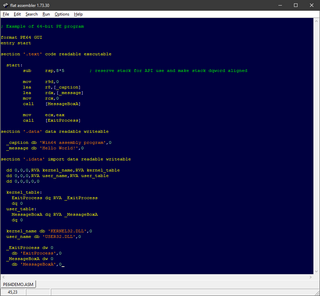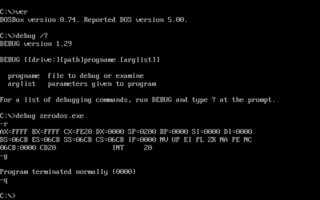
In computing, the Executable and Linkable Format, is a common standard file format for executable files, object code, shared libraries, and core dumps. First published in the specification for the application binary interface (ABI) of the Unix operating system version named System V Release 4 (SVR4), and later in the Tool Interface Standard, it was quickly accepted among different vendors of Unix systems. In 1999, it was chosen as the standard binary file format for Unix and Unix-like systems on x86 processors by the 86open project.
A disassembler is a computer program that translates machine language into assembly language—the inverse operation to that of an assembler. Disassembly, the output of a disassembler, is often formatted for human-readability rather than suitability for input to an assembler, making it principally a reverse-engineering tool. Common uses of disassemblers include recovering source code of a program whose original source was lost, malware analysis, modifying software, and software cracking.

The Netwide Assembler (NASM) is an assembler and disassembler for the Intel x86 architecture. It can be used to write 16-bit, 32-bit (IA-32) and 64-bit (x86-64) programs. It is considered one of the most popular assemblers for Linux.
The Portable Executable (PE) format is a file format for executables, object code, DLLs and others used in 32-bit and 64-bit versions of Windows operating systems. The PE format is a data structure that encapsulates the information necessary for the Windows OS loader to manage the wrapped executable code. This includes dynamic library references for linking, API export and import tables, resource management data and thread-local storage (TLS) data. On NT operating systems, the PE format is used for EXE, DLL, SYS, MUI and other file types. The Unified Extensible Firmware Interface (UEFI) specification states that PE is the standard executable format in EFI environments.

FASM is an assembler for x86 processors. It supports Intel-style assembly language on the IA-32 and x86-64 computer architectures. It claims high speed, size optimizations, operating system (OS) portability, and macro abilities. It is a low-level assembler and intentionally uses very few command-line options. It is free and open-source software.
x86 assembly language is the name for the family of assembly languages which provide some level of backward compatibility with CPUs back to the Intel 8008 microprocessor, which was launched in April 1972. It is used to produce object code for the x86 class of processors.
A fat binary is a computer executable program or library which has been expanded with code native to multiple instruction sets which can consequently be run on multiple processor types. This results in a file larger than a normal one-architecture binary file, thus the name.
Mach-O, short for Mach object file format, is a file format for executables, object code, shared libraries, dynamically-loaded code, and core dumps. It was developed to replace the a.out format.

The Interactive Disassembler (IDA) is a disassembler for computer software which generates assembly language source code from machine-executable code. It supports a variety of executable formats for different processors and operating systems. It can also be used as a debugger for Windows PE, Mac OS X Mach-O, and Linux ELF executables. A decompiler plug-in, which generates a high level, C source code-like representation of the analysed program, is available at extra cost.
ROM hacking is the process of modifying a ROM image or ROM file of a video game to alter the game's graphics, dialogue, levels, gameplay, and/or other elements. This is usually done by technically inclined video game fans to improve an old game of importance, as a creative outlet, or to make new, unofficial games using the old game's engine. ROM hacks either re-design a game for new, fun gameplay while keeping most if not all the items the same, or unlock/reimplement features that exist in the game's code but are not utilized in-game.
In software engineering, retargeting is an attribute of software development tools that have been specifically designed to generate code for more than one computing platform.

UPX is a free and open source executable packer supporting a number of file formats from different operating systems.
In computer security, executable-space protection marks memory regions as non-executable, such that an attempt to execute machine code in these regions will cause an exception. It makes use of hardware features such as the NX bit, or in some cases software emulation of those features. However, technologies that emulate or supply an NX bit will usually impose a measurable overhead while using a hardware-supplied NX bit imposes no measurable overhead.
OllyDbg was an x86 debugger that emphasizes binary code analysis, which is useful when source code is not available. It traces registers, recognizes procedures, API calls, switches, tables, constants and strings, as well as locates routines from object files and libraries. It has a user friendly interface, and its functionality can be extended by third-party plugins. Version 1.10 is the final 1.x release. Version 2.0 was released in June 2010, and OllyDbg has been rewritten from the ground up in this release. Although the current version of OllyDbg cannot disassemble binaries compiled for 64-bit processors, a 64-bit version of the debugger has been promised.

The line-oriented debugger DEBUG.EXE is an external command in operating systems such as DOS, OS/2 and Windows.

BEYE is a multiplatform, portable viewer of binary files with a built-in editor that functions in binary, hexadecimal and disassembler modes. It uses native Intel syntax for disassembly. Features include an AVR/Java/x86-i386-AMD64/ARM-XScale/PPC64 disassemblers, a Russian code pages converter, full preview of MZ, NE, PE, NLM, COFF32, ELF formats, partial preview of a.out, LE and LX, Phar Lap formats, and a code navigator.
Open Watcom Assembler or WASM is an x86 assembler produced by Watcom, based on the Watcom Assembler found in Watcom C/C++ compiler and Watcom FORTRAN 77. Further development is being done on the 32- and 64-bit JWASM project,. which more closely matches the syntax of Microsoft's assembler.

Radare2 is a complete framework for reverse-engineering and analyzing binaries; composed of a set of small utilities that can be used together or independently from the command line. Built around a disassembler for computer software which generates assembly language source code from machine-executable code, it supports a variety of executable formats for different processor architectures and operating systems.
010 Editor is a commercial hex editor and text editor for Microsoft Windows, Linux and macOS. Typically 010 Editor is used to edit text files, binary files, hard drives, processes, tagged data, source code, shell scripts, log files, etc. A large variety of binary data formats can be edited through the use of Binary Templates.
Binary Ninja is a reverse-engineering platform developed by Vector 35 Inc. It can disassemble a binary and display the disassembly in linear or graph views. It performs automated in-depth analysis of the code, generating information that helps to analyze a binary. It lifts the instructions into intermediate languages, and eventually generates the decompiled code.








